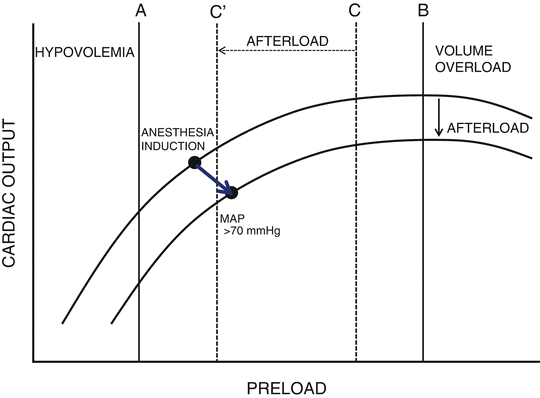Fig. 7.1
Conceptual diagram of high blood pressure management with volume loading alone

Fig. 7.2
Conceptual diagram of high blood pressure management with the proactive use of vasopressors
The perspective that hypotension can be treated with volume loading alone (Fig. 7.1) is based on the assumption that an imaginary “preload volume at which manipulation of the heart causes circulatory collapse” (dotted line C) is less than (left side) the boundary (perpendicular line B) showing harmful volume overload. However, with this method, it is difficult to judge in advance whether the target blood pressure (e.g., MAP >70 mmHg [3]) will be achieved without causing volume overload using fluids alone. In addition, post-volume loading preload (right dot) is further removed from the level at which hypovolemia is caused (perpendicular line A), indicating that any decrease in blood pressure is unlikely to have been caused by hypovolemia.
In contrast, the standpoint of proactive vasopressor use (Fig. 7.2) shows that increased afterload causes the Frank–Starling curve to move downward. It also hypothesizes an imaginary “preload volume at which manipulation of the heart causes circulatory collapse” (dotted line C → C′). Here, the target blood pressure, i.e., tissue oxygen demand, can be achieved without increasing preload with fluids. The fact that this standpoint also shows that preload (right dot) after vasopressor use is further moved compared with volume overload (perpendicular line B) is significant, making the aforementioned risks associated with vasopressor use acceptable.
Whatever standpoint is selected, one should not pay attention to blood pressure values alone. Rather, indices showing hemodynamic changes over time (CO, pulmonary capillary wedge pressure, transesophageal echocardiography findings, etc.) should be used to judge where the patient’s condition would fit in the figures described and manage the patient accordingly. Further research should be conducted on more accurate indices that can predict the effects of heart manipulation on hemodynamics.
When circulation management is not progressing well, it is important to conduct an objective assessment and alter or incorporate changes into the adopted strategy without being fixated on a certain type of management. Furthermore, when extreme increases in pressure or blockage of flow pathways occur during heart surgery, their management should be prioritized, requiring careful observation of the surgical field with close communication between the anesthesiologist and the surgeon. The use of an intra-aortic balloon pump should also be considered if necessary.
References
1.
Guyton RA, McClenathan JH, Newman GE, Michaelis LL (1977) Significance of subendocardial S-T segment elevation caused by coronary stenosis in the dog. Epicardial S-T segment depression, local ischemia and subsequent necrosis. Am J Cardiol 40(3):373–380. doi:0002-9149(77)90159-X [pii]
2.
3.
4.
Urso S, Sadaba JR, Pettinari M (2012) Impact of off-pump to on-pump conversion rate on post-operative results in patients undergoing off-pump coronary artery bypass. Interact Cardiovasc Thorac Surg 14:188–193PubMedCentralCrossRefPubMed
5.
Couture P, Denault A, Limoges P, Sheridan P, Babin D, Cartier R (2002) Mechanisms of hemodynamic changes during off-pump coronary artery bypass surgery. Can J Anaesth 49(8):835–849. doi:10.1007/BF03017418 [doi]
6.
Chassot PG, van der Linden P, Zaugg M, Mueller XM, Spahn DR (2004) Off-pump coronary artery bypass surgery: physiology and anaesthetic management. Br J Anaesth 92(3):400–413. doi:10.1093/bja/aeh064 [doi] 92/3/400 [pii]
7.
Bojar RM (ed) (2005) Manual of perioperative care in adult cardiac surgery, 4th edn. Blackwell Publishing, Oxford
Stay updated, free articles. Join our Telegram channel

Full access? Get Clinical Tree


